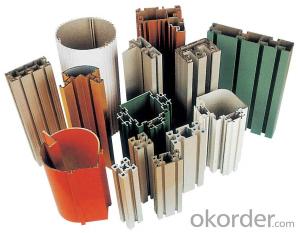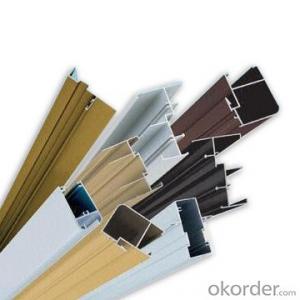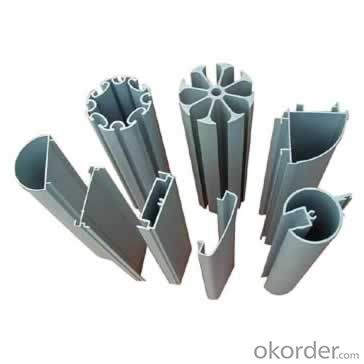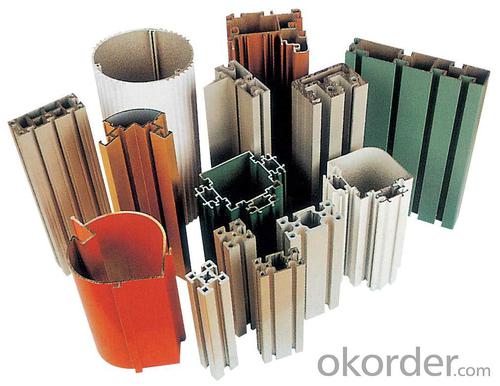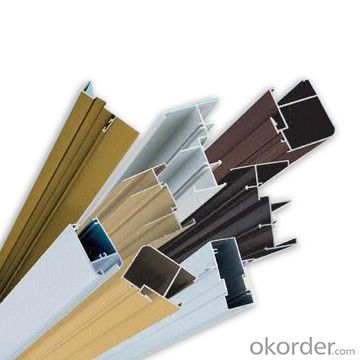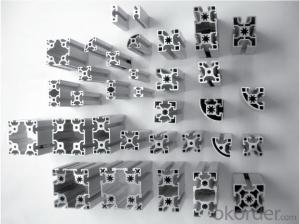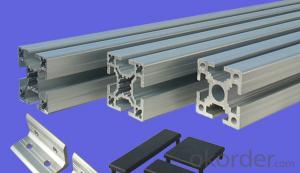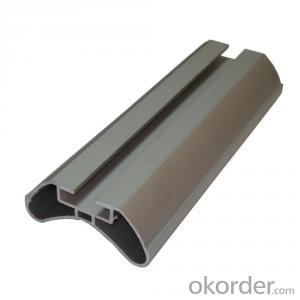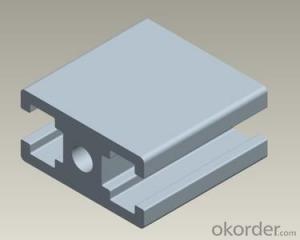Structural Aluminum Profiles - Alu Profile Extrusion 6061 T5
- Loading Port:
- China Main Port
- Payment Terms:
- TT OR LC
- Min Order Qty:
- -
- Supply Capability:
- -
OKorder Service Pledge
OKorder Financial Service
You Might Also Like
Aluminium is a relatively soft, durable, lightweight, ductileand malleablemetalwith appearance ranging from silvery to dull gray, depending on the surfaceroughness. It is nonmagnetic and does not easily ignite. A fresh film ofaluminium serves as a good reflector (approximately 92%) of visible lightand an excellent reflector (as much as 98%) of medium and far infraredradiation. The yield strength of pure aluminium is 7–11 MPa,while aluminium alloys have yield strengths ranging from200 MPa to 600 MPa. Aluminium has about one-third the densityand stiffness of steel. It is easily machined,cast, drawn and extruded.
Aluminium alloys (or aluminum alloys; see spellingdifferences) are alloysin which aluminium(Al) is the predominant metal. The typical alloying elements are copper, magnesium,manganese,silicon,tin and zinc. There are twoprincipal classifications, namely casting alloys and wrought alloys, both of which are furthersubdivided into the categories heat-treatableand non-heat-treatable. About 85% of aluminium is used for wrought products,for example rolled plate, foils and extrusions.Cast aluminium alloys yield cost-effective products due to the low meltingpoint, although they generally have lower tensile strengthsthan wrought alloys. The most important cast aluminium alloy system is Al–Si,where the high levels of silicon (4.0–13%) contribute to give good castingcharacteristics. Aluminium alloys are widely used in engineering structures andcomponents where light weight or corrosion resistance is required
Features:
Material | Alloy 6063,6061,6005or according to customer’s choice |
Temper | T3, T4, T5, T6 |
Surface | Anodize, electrophoresis, powder coating, PVDF coating, wood grain painting, matted, etc. |
Length | Coating 6.5 meters, Anodizing 6.5 meters, Mill finish 5 meters |
Application | Industrial, electrical equipment(TV set, air conditioner, refrigerator, computer), decoration,construction, transportation |
Custom Made | We can package following with customer's request. |
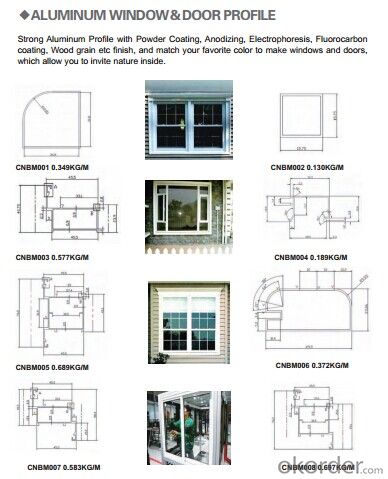


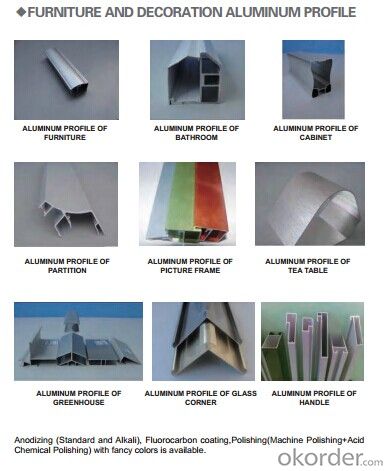
FAQ:
1. What is the form of payment?
Normally 30% TT, L/C at sight
2. Type of quotation?
FOB, CFR, CIF
3. Port of loading?
Shenzhen/Guangzhou port
4. Delivery time?
15-20 days after client’s deposit
- Q: Are aluminum profiles suitable for curtain walls and facades?
- Yes, aluminum profiles are highly suitable for curtain walls and facades. Aluminum is a lightweight and durable material that offers excellent strength, corrosion resistance, and design flexibility. It can be easily fabricated into various shapes and sizes, allowing for intricate and modern architectural designs. Additionally, aluminum profiles can accommodate large glass panels, providing ample natural light and enhancing the aesthetic appeal of buildings.
- Q: Aluminum profile connecting piece
- Very little to buy this alone, and only with industrial aluminum suppliers. - selling on Taobao is also a way if the price is appropriate.
- Q: Are there any materials for aluminum profiles?
- Yes, aluminum, silicon, aluminum, magnesium and so on
- Q: Who would like to know, aluminum radiator mainly used in which instruments or equipment, trouble to say more detailed points, thank you
- Large, such as ZTE, HUAWEI communications control center, as well as the main table server, large cabinet
- Q: Aluminum blackening formula
- Anodic oxidation of aluminum is aluminum or Aluminum Alloy anode to lead as cathode in sulfuric acid, oxalic acid, chromic acid and aqueous solution electrolysis, so that the surface oxide film. The anodic oxidation process is most widely used. Aluminum and Aluminum Alloy sulfuric acid anodizing oxidation film has high adsorption capacity, easy sealing alone or with colored more to improve the corrosion resistance of anodic oxide film thickness and appearance. The process is generally Aluminum Alloy sulfuric acid anodizing electrolyte has the advantages of simple operation, stable, cost is not high, the process is mature, but in sulfuric acid anodized process often unavoidable failure occurred, influence of oxide film quality. The following detailed analysis about the failure reasons, then give some preventive measures for your reference:Common faults and analysisAluminum Alloy products by sulfuric acid anodic oxidation, partial oxidation without touch, showing visible black spots or stripes, film drums or holes. The failure phenomenon of tumor is rare but has occurred.Dr. al website has detailed knowledge
- Q: Can aluminum profiles be extruded into hollow profiles?
- Yes, there are two ways to squeeze hollow profiles:1, in the die area, the use of shunt mold2, in the extruder processing, the use of punch pin, in general, this is for the double action extruder, used for extrusion seamless pipe. The reverse press also works.
- Q: What are the different bending and forming options for aluminum profiles?
- There are several bending and forming options available for aluminum profiles, each with its own advantages and applications. Some of the common methods include: 1. Cold bending: This is a widely used process that involves bending the aluminum profile using external force without the use of heat. Cold bending can be done manually or with the help of machinery such as press brakes or rollers. It is suitable for creating simple shapes and can be cost-effective for low volume production. 2. Heat bending: In this method, the aluminum profile is heated to a specific temperature, which makes it more malleable and easier to bend. Heat bending is often used for complex or precise shapes that cannot be achieved through cold bending. It requires specialized equipment, such as heating lamps or furnaces, and skilled operators to ensure accurate results. 3. Roll forming: This process involves passing the aluminum profile through a series of rollers to gradually shape it into the desired form. Roll forming is suitable for creating continuous shapes or long lengths of profiles with consistent dimensions. It is commonly used in industries such as construction, automotive, and furniture manufacturing. 4. Stretch forming: Stretch forming is a method that involves clamping the aluminum profile at its edges and stretching it over a form or mold. This process allows for the creation of complex curves and contours, making it ideal for applications that require intricate designs or unique shapes. Stretch forming is commonly used in aerospace, architectural, and automotive industries. 5. Hydroforming: Hydroforming uses pressurized fluid to shape the aluminum profile into a mold. The fluid pressure forces the metal to conform to the shape of the mold, resulting in precise and high-quality formed parts. Hydroforming is particularly advantageous for creating lightweight and structurally efficient components, making it popular in the automotive and aerospace industries. These bending and forming options provide a range of possibilities for shaping aluminum profiles to meet specific design requirements. The choice of method depends on factors such as the complexity of the desired shape, production volume, cost considerations, and the specific industry application.
- Q: Everybody good: please look at this section of the aluminum can not buy ready-made standard parts. If the mold needs to be opened, is it the extrusion process? About how much is the die charge?. Thank you.
- Is it ready to estimate?. Custom mold. If the simple section of the mold is about two thousand yuan (our company has many of these profiles on the outside to buy), the mold fee is in a certain amount can be returned.
- Q: How do aluminum profiles perform in terms of impact resistance?
- Aluminum profiles are known for their excellent impact resistance. Due to their inherent strength and durability, aluminum profiles can withstand significant impact without getting deformed or damaged easily. The high strength-to-weight ratio of aluminum makes it ideal for applications where impact resistance is crucial, such as in the automotive, aerospace, and construction industries. Aluminum profiles have the ability to absorb and distribute impact energy throughout their structure, which helps prevent localized damage. This property is particularly beneficial in situations where the material needs to withstand sudden shocks, collisions, or heavy loads. Furthermore, aluminum profiles can also be designed with specific reinforcements or structural elements to enhance their impact resistance further. This allows for customization to meet specific requirements or to address potential impact-prone areas. Overall, aluminum profiles are highly regarded for their exceptional impact resistance, making them a preferred choice in various industries and applications where durability and strength are vital.
- Q: Can aluminum profiles be used for electrical applications?
- Aluminum profiles possess the capability to be utilized in electrical applications. Given its high conductivity, aluminum emerges as an ideal choice for facilitating electrical conduction. In the realm of electrical applications, aluminum profiles frequently find employment in power distribution systems, wiring conduits, and bus bars. By virtue of being lightweight and cost-effective, they present a favorable solution for electrical installations. Moreover, aluminum profiles exhibit commendable thermal conductivity, successfully aiding in the dissipation of heat emitted by electrical components. Nevertheless, it remains crucial to duly factor in the specific requirements of the electrical application at hand, ensuring that the aluminum profiles adhere to the requisite electrical safety standards and regulations.
Send your message to us
Structural Aluminum Profiles - Alu Profile Extrusion 6061 T5
- Loading Port:
- China Main Port
- Payment Terms:
- TT OR LC
- Min Order Qty:
- -
- Supply Capability:
- -
OKorder Service Pledge
OKorder Financial Service
Similar products
Hot products
Hot Searches
Related keywords

